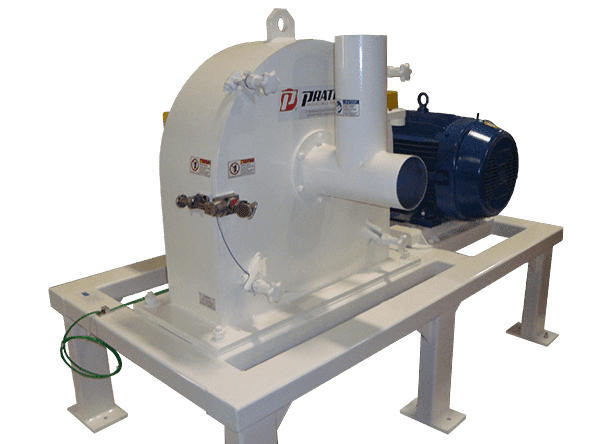- Activated Carbon
- Alfalfa Leaves
- Boric Acid
- Boron Nitrate
- Bran
- Calcium Carbonate
- Caraway Seed
- Carbon
- Cellulose Insulation
- Charcoal
- Chocolate and Malts
- Chrome, Green, Red and Yellow
- Clay
- Coal
- Cocoa
- Coffee
- Coke
- Copper Sulfate
- Corn Meal and Corn Starch
- Dextrose
- Egg Shells
- Epoxy Resin
- Flour
- Gelatin
- Graphite
- Gypsum
- Iron Oxide
- Lactose
- Limestone
- Magnesium Hydroxide
- Oat Hulls
- Pepper
- Perlite
- Phenolic Resin
- Physllum Husks
- Pigment
- Powder Coating
- Pre-Ground Corn
- Radioactive Material
- Resins
- Rice and Rice Hulls
- Salt
- Soda Ash
- Sodium Caseinate and Sodium Bicarbonate
- Soya Concentrate and Soya Protein
- Soybean
- Spices
- Starch
- Sugar 6x (M-21), 8x (M-36), 8x – 10x – 12x (M-101)
- Talc
- Toner
- Wheat
- Wood Flour
- Yellow Pigment
- Zinc Oxide
FEATURES
- Final product size 60 – 400 mesh
- External bearing assembly
- Dynamically balanced reversible rotor assembly
- Tight clearances between rotor & fixed grinding elements
- Dual O-ring door seal with floating door hinge for a positive seal
- Replaceable grinding blades
- Sanitary construction available
BENEFITS
- More capacity
- Better dust control
- Precise control of finished particle size and distribution
- Simple maintenance
- Standard safety features

Prater Fine Grinders (M Series Mills) are designed to grind dry, free-flowing material as fine as 400 mesh (37 microns) with a very tight distribution of particle size. The highly efficient design allows for ease of access to all internals and is well suited for heat-sensitive materials such as resins and sugar. Six sizes are available from the 3 HP M-19 bench-scale lab mill to the 250 HP M-101.
A close tolerance between the rotor blades and the grinding jaw/screen frame assembly are designed to produce a more uniform and finer grind. The larger screen to horsepower ratio allows for more capacity. Dual “O” rings seals on the large access door and outboard bearings allow for better dust control. Removing one bolt allows quick removal of the rotor, which is reversible. Rotor blades are easily replaced without further rotor balancing needed.
Prater Fine Grinders utilize a high-speed impact principle. The feed material is metered into the center of the mill, where it is impacted by the rotor. The feed material is then thrown outward where it impacts with other particles, aiding in the reduction process. After initial impact, particles are projected across the screen and are sheared between the blades of the rotor and the sizing screen or jaws. This action continues until the particles are properly sized and are discharged through the bottom of the mill. Precision tolerances are maintained between the rotor blades and the stationary grinding surfaces to allow for precise control of finished particle size and distribution.
All Prater Fine Grinders come with an automatic door interlock. This device prevents access to mill internals during operation and prevents dangerous motion during access.
PRATER FINE GRINDER CASE STUDIES
M SERIES FINE GRINDER GENERAL DIMENSIONS
| MODEL NUMBER | HP | OVERALL WIDTH | OVERALL HEIGHT |
| M-19 | 3-5 | 13 in. 330 mm |
12.5 in. 318 mm |
| M-21 | 10-15 | 27 in. 559 mm |
19 in. 483 mm |
| M-36 | 20-30 | 35.75 in. 908 mm |
26.5 in. 673 mm |
| M-51 | 40-60 | 44 in. 1118 mm |
34 in. 864 mm |
| M-76 | 75-125 | 65 in. 1651 mm |
48 in. 1219 mm |
| M-101 | 125-250 | 77 in. 1956 mm |
64 in. 1626 mm |
*Do not use for engineering purposes. Please request a certified drawing for all layout or construction uses.
